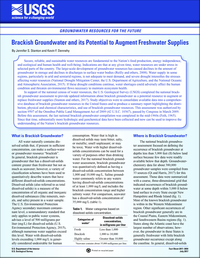Brackish groundwater and its potential to augment freshwater supplies
Links
- Document: Fact Sheet (2.38 MB pdf)
- Companion File: Professional Paper 1833 Brackish groundwater in the United States
- Data Release: USGS - Data Release - Geochemical database for the brackish groundwater assessment of the United States
- Download citation as: RIS | Dublin Core
Abstract
Secure, reliable, and sustainable water resources are fundamental to the Nation’s food production, energy independence, and ecological and human health and well-being. Indications are that at any given time, water resources are under stress in selected parts of the country. The large-scale development of groundwater resources has caused declines in the amount of groundwater in storage and declines in discharges to surface water bodies (Reilly and others, 2008). Water supply in some regions, particularly in arid and semiarid regions, is not adequate to meet demand, and severe drought intensifies the stresses affecting water resources (National Drought Mitigation Center, the U.S. Department of Agriculture, and the National Oceanic and Atmospheric Association, 2015). If these drought conditions continue, water shortages could adversely affect the human condition and threaten environmental flows necessary to maintain ecosystem health.
In support of the national census of water resources, the U.S. Geological Survey (USGS) completed the national brackish groundwater assessment to provide updated information about brackish groundwater as a potential resource to augment or replace freshwater supplies (Stanton and others, 2017). Study objectives were to consolidate available data into a comprehensive database of brackish groundwater resources in the United States and to produce a summary report highlighting the distribution, physical and chemical characteristics, and use of brackish groundwater resources. This assessment was authorized by section 9507 of the Omnibus Public Land Management Act of 2009 (42 U.S.C. 10367), passed by Congress in March 2009. Before this assessment, the last national brackish groundwater compilation was completed in the mid-1960s (Feth, 1965). Since that time, substantially more hydrologic and geochemical data have been collected and now can be used to improve the understanding of the Nation’s brackish groundwater resources.
Suggested Citation
Stanton, J.S., and Dennehy, K.F., 2017, Brackish groundwater and its potential to augment freshwater supplies: U.S. Geological Survey Fact Sheet 2017–3054, 4 p., https://doi.org/10.3133/fs20173054.
ISSN: 2327-6932 (online)
ISSN: 2327-6916 (print)
Study Area
Table of Contents
- What is Brackish Groundwater?
- Where is Brackish Groundwater?
- What Chemical Factors Affect the Usability of Brackish Groundwater?
- What Physical Factors Affect the Usability of Brackish Groundwater?
- Can Brackish Groundwater be Used as an Alternative to Freshwater Resources?
- For More Information
- References Cited
| Publication type | Report |
|---|---|
| Publication Subtype | USGS Numbered Series |
| Title | Brackish groundwater and its potential to augment freshwater supplies |
| Series title | Fact Sheet |
| Series number | 2017-3054 |
| DOI | 10.3133/fs20173054 |
| Publication Date | July 18, 2017 |
| Year Published | 2017 |
| Language | English |
| Publisher | U.S. Geological Survey |
| Publisher location | Reston, VA |
| Contributing office(s) | Nebraska Water Science Center |
| Description | Document: 4 p.; Companion File; Data Release |
| Country | United States |
| Online Only (Y/N) | N |


